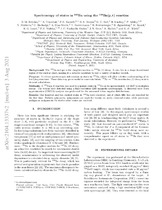| dc.contributor.author | Rebeiro, B.M. | |
| dc.contributor.author | Triambak, S. | |
| dc.contributor.author | Garrett, P.E. | |
| dc.contributor.author | Lindsay, R. | |
| dc.date.accessioned | 2021-10-01T13:19:58Z | |
| dc.date.available | 2021-10-01T13:19:58Z | |
| dc.date.issued | 2021 | |
| dc.identifier.citation | Rebeiro, B. & Triambak, Smarajit & Garrett, Paul & Brown, B. & Ball, G. & Lindsay, Robert & Adsley, P. & Bildstein, Vinzenz & Burbadge, Christina & Diaz Varela, A. & Faestermann, Thomas & Hertenberger, R. & Jigmeddorj, Badamsambuu & Kamil, Mohamed & Leach, Kyle & Mabika, P. & Nzobadila Ondze, Jespere Calderone & Orce, Nico & Radich, A. & Wirth, H.-F. (2021). Spectroscopy of states in Ba 136 using the Ba 138 ( p , t ) reaction. Physical Review C. 104. 10.1103/PhysRevC.104.034309. | en_US |
| dc.identifier.issn | 24699985 | |
| dc.identifier.uri | 10.1103/PhysRevC.104.034309 | |
| dc.identifier.uri | http://hdl.handle.net/10566/6854 | |
| dc.description | We thank Marcus Scheck for fruitful discussions. Funding support from the National Research Foundation (NRF), South Africa, under Grant No. 85100, the U.S. Department of Energy Office of Science under Grants No. DE-SC0017649 and No. DE-FG02-93ER40789 and the National Science Foundation under Grant No. PHY-1811855 are gratefully acknowledged. P.A. thanks the Claude Leon Foundation for his postdoctoral fellowship. P.Z.M. and J.C.N.O. are grateful to the NRF funded MaNuS/MatSci program at UWC for financial support during their M.Sc. | en_US |
| dc.description.abstract | Background: The Ba136 isotope is the daughter nucleus in Xe136ββ decay. It also lies in a shape transitional region of the nuclear chart, making it a suitable candidate to test a variety of nuclear models. Purpose: To obtain spectroscopic information on states in Ba136, which will allow a better understanding of its low-lying structure. These data may prove useful to constrain future Xe136→Ba136 neutrinoless ββ decay matrix element calculations. Methods: A Ba138(p,t) reaction was used to populate states in Ba136 up to approximately 4.6 MeV in excitation energy. The tritons were detected using a high-resolution Q3D magnetic spectrograph. A distorted wave Born approximation analysis was performed for the measured triton angular distributions. Results: 102 excited states in Ba136 were observed, out of which 52 are reported for the first time. Definite spin-parity assignments are made for 26 newly observed states, while previously ambiguous assignments for ten other states are resolved. Together with other available data, the results are used to determine level densities in Ba136. These were compared with theory predictions, obtained using shell model calculations with Hamiltonians previously used for Xe136 neutrinoless ββ decay matrix element evaluations. Conclusions: The shell model predicted level densities agree reasonably well for the two Hamiltonians. However, the results for theory and experiment are found to agree only at lower energies, diverging from one another for the higher lying states, with the discrepancy increasing with energy. This is presumably because of lower production cross-sections for a majority of the higher-lying predicted states and the experimental limitations in resolving a large number of nearly degenerate states predicted by the theory. © 2021 American Physical Society. | en_US |
| dc.description.sponsorship | University of the Western Cape (UWC)
National Science Foundation (NSF): PHY-1811855
U.S. Department of Energy (USDOE): DE-FG02-93ER40789; DE-SC0017649
National Research Foundation (NRF): 85100 NRF
Claude Leon Foundation | en_US |
| dc.language.iso | en | en_US |
| dc.publisher | American Physical Society | en_US |
| dc.subject | Ba136 Isotope | en_US |
| dc.subject | Xe136ββ decay | en_US |
| dc.subject | Nuclear chart | en_US |
| dc.subject | Nuclear model | en_US |
| dc.subject | Spectroscopic information | en_US |
| dc.subject | Q3D magnetic spectrograph | en_US |
| dc.subject | Tritons | en_US |
| dc.title | Spectroscopy of states in Ba 136 using the Ba 138 (p,t) reaction | en_US |
| dc.type | Article | en_US |

